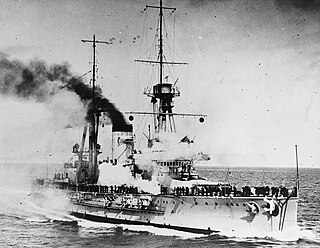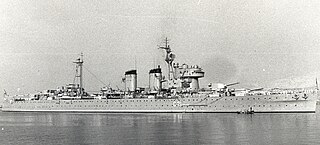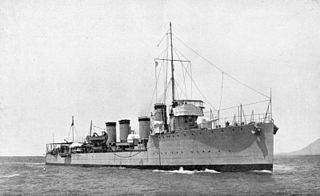Related Research Articles

A cruiser is a type of warship. Modern cruisers are generally the largest ships in a fleet after aircraft carriers and amphibious assault ships, and can usually perform several roles.

The Kriegsmarine was the navy of Germany from 1935 to 1945. It superseded the Imperial German Navy of the German Empire (1871–1918) and the inter-war Reichsmarine (1919–1935) of the Weimar Republic. The Kriegsmarine was one of three official branches, along with the Heer and the Luftwaffe, of the Wehrmacht, the German armed forces from 1935 to 1945.

The capital ships of a navy are its most important warships; they are generally the larger ships when compared to other warships in their respective fleet. A capital ship is generally a leading or a primary ship in a naval fleet.

The Soviet Navy was the naval warfare uniform service branch of the Soviet Armed Forces. Often referred to as the Red Fleet, the Soviet Navy made up a large part of the Soviet Union's strategic planning in the event of a conflict with the opposing superpower, the United States, during the Cold War (1945–1991). The Soviet Navy played a large role during the Cold War, either confronting the North Atlantic Treaty Organization in western Europe or power projection to maintain its sphere of influence in eastern Europe.
The Battle of Cape Spartel was a naval battle of the Spanish Civil War that broke the Republican blockade of the Strait of Gibraltar, securing the maritime supply route to Spanish Morocco for the Nationalists early in the war. The action occurred on 29 September 1936 between two Nationalist cruisers and two Republican destroyers.

The QF 3-pounder Hotchkiss or in French use Canon Hotchkiss à tir rapide de 47 mm were a family of long-lived light 47 mm naval guns introduced in 1886 to defend against new, small and fast vessels such as torpedo boats and later submarines. There were many variants produced, often under license which ranged in length from 32 to 50 calibers but 40 caliber was the most common version. They were widely used by the navies of a number of nations and often used by both sides in a conflict. They were also used ashore as coastal defense guns and later as an anti-aircraft gun, whether on improvised or specialized HA/LA mounts.

Alfonso XIII was the second of three España-class dreadnought battleships built in the 1910s for the Spanish Navy. Named after King Alfonso XIII of Spain, the ship was not completed until 1915 owing to a shortage of materials that resulted from the start of World War I the previous year. The España class was ordered as part of a naval construction program to rebuild the fleet after the losses of the Spanish–American War; the program began in the context of closer Spanish relations with Britain and France. The ships were armed with a main battery of eight 305 mm (12 in) guns and were intended to support the French Navy in the event of a major European war.

Jaime I was a Spanish dreadnought battleship, the third and final member of the España class, which included two other ships: España and Alfonso XIII. Named after King James I of Aragon, Jaime I was built in the early 1910s, though her completion was delayed until 1921 owing to a shortage of materials that resulted from the start of World War I the previous year. The class was ordered as part of a naval construction program to rebuild the fleet after the losses of the Spanish–American War in the context of closer Spanish relations with Britain and France. The ships were armed with a main battery of eight 305 mm (12 in) guns and were intended to support the French Navy in the event of a major European war.

The Churruca class was a Spanish destroyer class built for the Spanish Navy based on a British design. Eighteen ships were built, with two being sold to Argentina and commonly referred to as the Cervantes class. The last two members of the class are sometimes referred to as a separate class, the Alava class.

Sánchez Barcáiztegui was a Churruca-class destroyer of the Spanish Republican Navy. She took part in the Spanish Civil War on the side of the government of the Second Spanish Republic.

Almirante Cervera was a light cruiser and lead ship of the Almirante Cervera class of the Spanish Navy. She was named after the Spanish admiral Pascual Cervera y Topete, commander of the Spanish naval forces in Cuba during the Spanish–American War. She was part of the Spanish Republican Navy between 1931 and 1936, year in which she became a key player of the Nationalist Fleet in the Spanish Civil War.

Canarias was a Canarias-class heavy cruiser of the Spanish Navy. She was built in Spain by the Vickers-Armstrongs subsidiary Sociedad Española de Construcción Naval based on a British design, being a modified version of the Royal Navy′s County class. Canarias saw service during the Spanish Civil War.

The Convoy de la Victoria was a Spanish naval battle on 5 August 1936 in the Strait of Gibraltar during the Spanish Civil War, between the escort of a Nationalist convoy and the Republican Navy destroyer Alcalá Galiano.

The Alsedo class was a Spanish class of destroyer. Three ships were built, based on a British design, entering service between 1924 and 1925. They all served through and survived the Spanish Civil War, two on the Republican side and one with the Nationalists. The class was retired in 1957–1961.

The Spanish Republican Navy was the naval arm of the Armed Forces of the Second Spanish Republic, the legally established government of Spain between 1931 and 1939.

Quarto was a unique protected cruiser built by the Italian Regia Marina in the 1910s. Her keel was laid in November 1909, she was launched in August 1911, and was completed in March 1913. She was the first Italian cruiser to be equipped with steam turbines, which gave her a top speed of 28 knots. Her high speed was a requirement for the role in which she was designed to serve: a scout for the main Italian fleet.
References
- ↑ "Warships of the Spanish Civil War (1936-1939) - Battleships". www.kbismarck.com. Retrieved 9 July 2021.
- 1 2 "Cruisers of Spanish Civil War (1936-1939)". www.kbismarck.com. Retrieved 9 July 2021.
- 1 2 "Destroyers of the Spanish Civil War (1936-1939)". www.kbismarck.com. Retrieved 8 August 2021.
- 1 2 encyclopedia, david bocquelet-Naval. "WW2 Spanish Submarines (1859-1945)". www.naval-encyclopedia.com. Retrieved 8 August 2021.